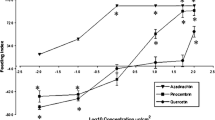Abstract
The heartwood of the tropical treeLonchocarpus castilloi Standley (Leguminosae) is highly resistant to attack by the drywood termitesCryptotermes brevis (Walker); nevertheless successive extraction with hexane, diethyl ether, acetone, methanol, and water reduced its resistance to these organisms. Antitermitic properties of the extracts were bioassayed using impregnated filter paper disks. Although the five extracts reduced both feeding and survival ofC. brevis, no significant differences among them were detected. Choice feeding tests showed that termites avoided eating the paper treated with the extracts. Two flavonoid compounds isolated from the heartwood, castillen D and castillen E, impregnated into filter paper showed concentration-dependent feeding deterrent activity, but were not toxic toC. brevis.
Similar content being viewed by others
References
Bárcenas-Pazos, G.M. 1995. Caracterización tecnológica de veinte especies maderables de la Selva Lacandona.Madera y Bosques (Mexico) 1(1):9–38.
Bárcenas-Pazos, G.M., Rejon, R.R., andEchenique-Manrique, R. 1980. Especies Maderables de la Selva Lacandona. La Madera y su Uso en la Construcción. No. 6. INIREB, Xalapa, México, 18 pp.
Carter, F.L., andde Camargo, C.R.R. 1983. Testing antitermitic properties of Brazilian woods and their extracts.Wood Fib. Sci. 15(4):350–357.
Carter, F.L., Beal, R.H., andBultman, J.D. 1975. Extraction of antitermitic substances from 23 tropical hardwoods.Wood Sci. 8(1):406–410.
Déon, G., Chadenson, M., andHauteville, M. 1980. Influence des extraits naturels du bois sur sa résistance a la pourriture.Bois For. Trop. 191:75–90.
Echenique-Manrique, R. 1970. Descripción, Características y Usos de 25 Maderas Tropicales Mexicanas. Serie Maderas de México. Biblioteca del Constructor No. 5. CANAIC, Mexico. 237 pp.
Gómez-Garibay, F., Reyes-Chilpa, R., Quijano, L., Pardo-Calderón, J.S., andRíos-Castillo, T. 1990. Methoxy furan auranols with fungistatic activity fromLonchocarpus castilloi.Phytochemistry 29(2):459–463.
Hart, J.H., andHillis, W.E. 1972. Inhibition of wood-rotting fungi by ellagitannins in the heart-wood ofQuercus alba.Phytopathology 62:620–626.
Hart, J.H., andShrimpton, D.M. 1979. Role of stilbenes in resistance of wood to decay.Phytopathology 69:1138–1143.
Khanna R.N., andSeshadri, T.R. 1963. Pongaglabrone, a new component of the seed ofPongamia glabra its constitution and synthesis.Tetrahedron 19:219–225.
Kreckova, J., Krecek, J., andHarmatha, J. 1988. Feeding deterrent activity of certain plant substances against subterranean termiteCoptotermes formosanus (Rhinotermitidae; Isoptera),in F. Sehnal, A. Zabza, and D.L. Denlinger, (eds.). Endocrinological Frontiers in Physiological Insect Ecology. Wroclaw Technical University Press, Wroclaw, p. 105–107.
Laks, P.E. 1988. Wood preservative as trees do it.Am. Wood Pres. Assoc. 1988:147–155.
McDaniel, C.A. 1992. Major antitermitic components of the heartwood of southern catalpa.J. Chem. Ecol. 18(3):359–639.
Ortega-Escalona, F., Castillo-Morales, I., andCarmona-Valdovinos, T. 1991. Anatomía de la madera de veintiseis especies de la Selva Lacandona, Chiapas. La Madera y su Uso, Vol. 26. Instituto de Ecología A.C.-Universidad Autónoma Metropolitana, Xalapa, México, 200 pp.
Pérez-Morales, V., Segura-Warnholtz, G. andBrunhuber-Menéndez, J.L. 1984. Resistencia natural de 18 especies de maderas mexicanas contra el ataque de termitas de madera seca,Cryptotermes brevis (Walker), (Kalotermitidae, Isóptera). Memorias del Congreso Mexicano de Patología Forestal, September 26–29, 1984. Durango, México.
Reyes-Chilpa, R. 1986. Los metabolitos secundarios en la resistencia natural de la madera a la pudrición: Nuevos flavonoides fungistáticos aislados deLonchocarpus castilloi. MSc thesis. INIREB, Xalapa, México. 95 pp.
Reyes-Chilpa, R., Pérez-Morales, V. anddel Angel-Blanco, S. 1987. Influencia de los extractivos en la resistencia natural de seis maderas tropicales al hongo de pudrición morenaLenzites trabea. Biótica (México) 12(1):7–13.
Scheffrahn, R.H. 1991. Allelochemical resistance of wood to termites.Sociobiology 19(1):257–281.
Supriana, N. 1983. Preliminary tests on the effect of naturally occurring chemicals on termites. IRG/WP/1181. Fourteenth Annual Meeting of the International Research Group on Wood Preservation. Australia, May 1983, 11 pp.
Williams, R.M.C. 1980. A visit to Mexico to advise on the termite research programe at INIREB (LACITEMA) Xalapa, Veracruz, November 7–29, 1980. Report CVR/81/5. Manuscript of limited distribution. Centre for Overaseas Pest Research, London, 17 pp.
Wolcott, G.N. 1953. Stilbene and comparable materials for dry wood termite control.J. Econ. Entomol. 46(2):374–375.
Author information
Authors and Affiliations
Rights and permissions
About this article
Cite this article
Reyes-Chilpa, R., Viveros-Rodríguez, N., Gómez-Garibay, F. et al. Antitermitic activity ofLonchocarpus castilloi flavonoids and heartwood extracts. J Chem Ecol 21, 455–463 (1995). https://doi.org/10.1007/BF02036742
Received:
Accepted:
Issue Date:
DOI: https://doi.org/10.1007/BF02036742




